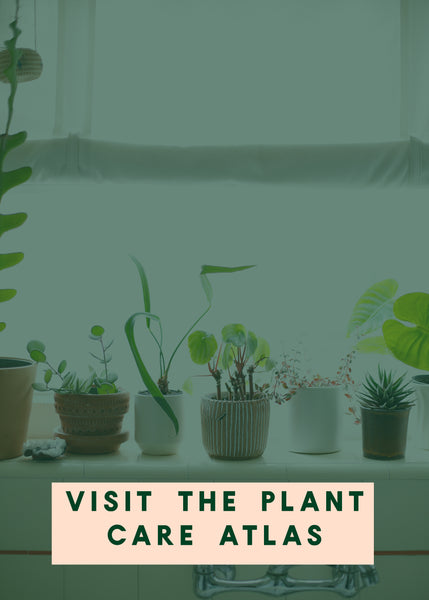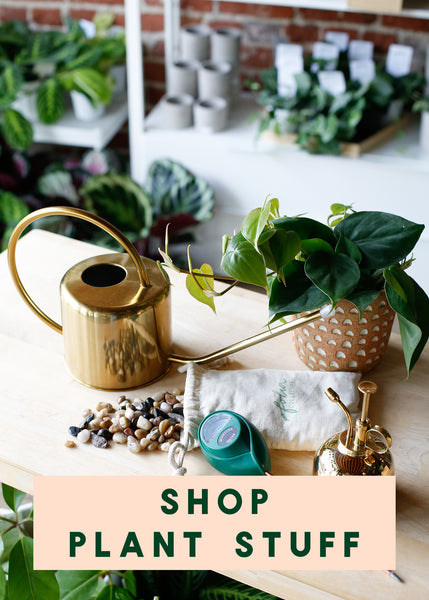Ask A Plant Pro: Pot Size

Every month we answer a customer-submitted plant question, think of it like a Dear Abby column but for plant-related questions. This month's submission:
Dear Plant Pro,
How do you tell what size pot you should use for your plant?
- Pot puzzled in Pasadena
Proper pot size is an important and often misunderstood factor in keeping plants healthy, but the good news is that getting it right is fairly simple.
Why does pot size matter?
The larger the pot, the more soil it can hold, and the more soil in a pot, the more moisture is held in that soil. If there's more moisture in that soil than the plant potted in it can utilize in a reasonable amount of time, roots can start to suffer from a lack of oxygen and die off - this is often known as 'root rot'.

How do I know it's time to move a plant to a larger pot?
There are two easy ways to tell if your plant is ready for a bigger pot:
- Roots coming out of the drainage holes. If you see a bunch of roots escaping through the drainage holes, or can see them pressing against the sides of the pot (in a nursery pot), that's a sign it's safe to repot.
- A change in how long the plant can go between waterings. If you have a plant that's normally ready for water in a week for instance and now it's dried out in just a few days, with no other environment changes (like hotter temps, a move to a brighter window, etc), that may be a sign it's time for a bigger pot. As a plant's root system grows and fills up the pot, soil is often displaced or caught in-between roots and compacted over time. The more compacted the soil is, or the less soil is in the pot, the less water can be stored in that soil, so when you water a lot of the water just runs over the roots and out of the pot. This leads to the plant drying out much faster than when it had more loose soil.
If you're not seeing either of these signs, but it's been more than a year since a plant was last potted, you can also check how pot bound (aka root bound) the plant is by gently slipping the whole root ball (the soil + roots) out of the pot. If the roots have taken on the shape of the pot, there is a wall of roots all the way to the edge of the root ball, or there are way more roots than soil - it's time for a bigger pot.
So how do I choose the right size?
The simplest rule of thumb is to size up 2" in diameter at a time. So if your plant is currently in a 4" pot, you'll want to move it up to a 6" pot.
Plants with very shallow or fine root systems like cacti, succulents, Sansevieria, Peperomia, Ceropegia, etc don't even need to be moved up a full inch in diameter since it usually takes quite a long time for their roots to fill more space.
Very large plants like trees can usually be moved up more than 2" in diameter if they have vigorous root systems but 2" will always be a safe jump up in size.
If you're potting up a plant that isn't in a pot already (like a cutting, or a plant shipped to you bare-root), then the best way to determine the pot size is to gently wind the roots into a pot shape and then add 2" to whatever diameter the roots alone can fill.

What if I don't like the way a plant looks in the correct sized pot?
Aesthetics are of course a consideration when choosing a pot, but the health of the plant should be the first priority. Rather than risking killing the plant by placing it in a pot that's a bad size match, here are a few of my tried and true plant styling tricks that balance plant health and aesthetics:
- Cachepots are your friend. Keeping a plant in a plastic nursery pot, then placing it inside a decorative pot allows you to pair plants with pots that are bigger without the risk to the plant. Just remove the plastic pot when you water so that excess water can drain out, then return to the decorative pot.
- Prop it up. If a plant sits too low in a decorative pot, place something waterproof like a repurposed lid, styrofoam packing pieces, or even pebbles underneath until the plant looks right in the pot.
- Drainage is key. If you need to go up slightly bigger than is ideal, ensure your potting mix is very fast draining and your container has good drainage as well. Adding material like pumice or larger sized bark chunks can help add more air pockets to soil, which helps keep roots healthier, and allows soil to drain faster/dry out faster.
Now that you know the 'why' behind choosing the right pot size, and the 2" rule of thumb, I hope you feel ready to pick out new pots with confidence!
Ready to shop planters?
At Folia we have an assortment of pots to choose from, both online and in our brick and mortar shop.
Shop our in stock pots below:





